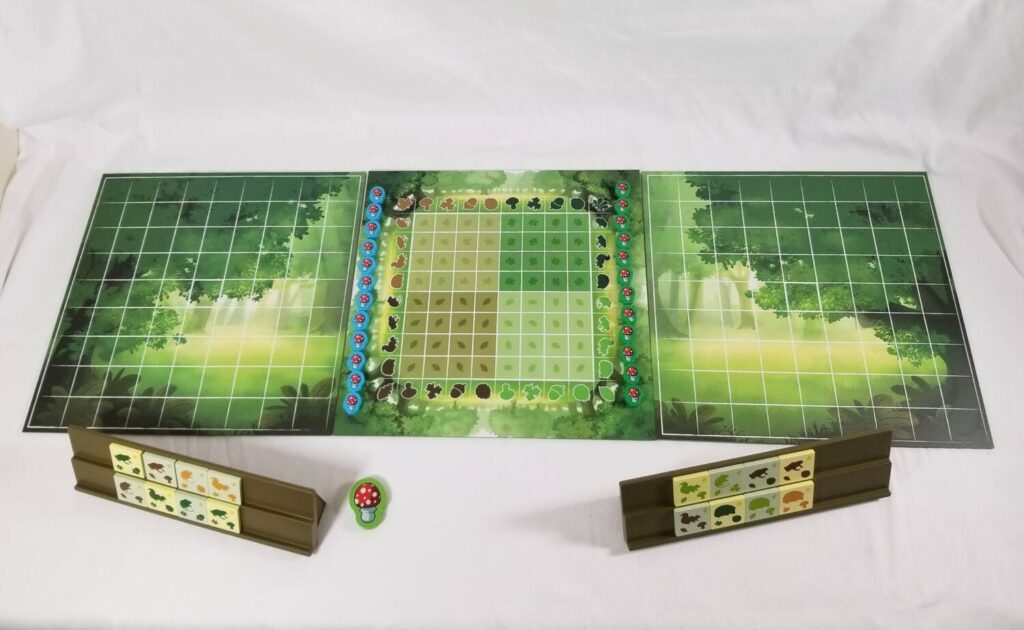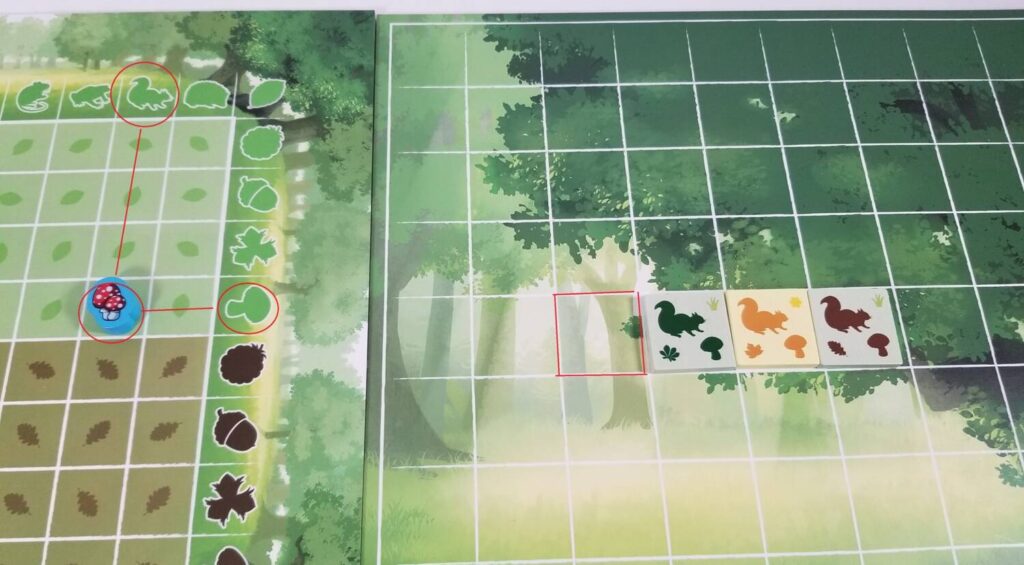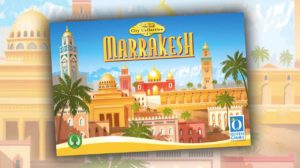From the rulebook: “It’s summertime. Amid the forest lies the glade. Bring your forest to life with creatures, leaves and forest fruits. Create sets of 3 tiles to place a toadstool into the glade. Complete a set of 4 tiles to add a toadstool into your store. Use toadstools in your store for extra actions.”
That’s The Glade in a nutshell (pun totally intended). In this quaint, abstract, tile-laying game from renowned designer Richard Breese (Keyflower, Keyper), the players will be drawing tiles from a bag, adding them to their tile rack, and then placing tiles into their tableau to create sets and score points. And when all is said and done and the last leaf has fallen, the player with the most points wins.
Of course this is a very high-level overview of the game. If you just want to know what I think, feel free to skip ahead to the Thoughts section. Otherwise, read on as we learn how to play The Glade.
Setup
A game of The Glade is set up thusly:

Place the Glade board in the middle of the playing area. Then, each player receives a Forest board (turned to its basic side*) which they place next to the Glade board, abutting it. Next, each player selects a color and receives the Toadstool counters of their chosen color—which they place alongside the edge of the Glade board, single toadstool side up—and a tile rack.
After this, the Forest tiles are placed into the cloth bag, which is given a good shake. Then, each player draws eight tiles from the bag, which they place onto their tile racks, hidden from the view of other players. A starting player is chosen by some means and given the Start Player marker. And, with that, you are ready to begin playing The Glade.
*There is also an advanced side (called the “matching game”) which I will touch upon later.
Understanding Sets
The core focus of The Glade is the creation, and completion, of sets. So, it behooves the players to have a firm grasp on what exactly constitutes a set. The rulebook defines a set as “1‒4 tiles that have at least 1 shared characteristic and other characteristics that are either all the same or all different.”
That sounds confusing, so I’ll clarify it with a few examples. Firstly, though, let’s talk about a tile’s characteristics. Each tile in The Glade is either light green or light yellow. The tile’s color corresponds to an icon of either a sun (yellow) or some grass (green) in the upper right hand corner. This characteristic is there for an eventual expansion and has no importance in the game and can be ignored. I bring this up because it caused some confusion and consternation in a couple of games that I played.

Also featured on each tile is an image of an animal (hedgehog, mouse, squirrel, or toad) in a specific color, which corresponds to a specific leaf shape printed in the bottom left corner of each tile (beech = light green, horse chestnut = dark green, maple = light brown, and oak = dark brown). The leaf icons are just there as a colorblind friendly reminder of the color of the other icons on the tile. Lastly, in the bottom right corner of each tile is a forest fruit (acorn, blackberry, hazelnut, mushroom) in the same color as the animal and leaf icon.
So, when talking about sets, there are three things we’re looking at: the color, the animal type, and the forest fruit. If only one thing in your group of tiles matches and everything else is different, you have a set with a single shared characteristic.

If you have a group of tiles that have two things that match (same animal, same color, for instance), then you have a set with two shared characteristics.

Inside the box are two matched sets of 64 Forest tiles. Their only difference is the color of the tile itself which, as I mentioned earlier, is irrelevant. Because of this, there is no possible way to ever have a complete set of four tiles with three matching characteristics. It is also impossible to ever have a set composed of more than four tiles.
A Walk Through the Glade
On your turn, you’ll have one of two options available to you: Place 1-4 Tiles or Claim a Toadstool.
At least one tile of your first set must be placed on top of the center space. Other than that, you can place your tiles anywhere on your Forest board you wish so long as the tiles you placed are a legal set and that they create legal sets if they happen to be placed up against previously placed tiles. If you’ve created a single- or double-tile set, nothing special happens. You just draw back up to eight tiles and play passes to the next person in line.
However, when the tiles you place cause a set of three to spring into existence, you will need to figure out which tile would complete the set and then mark that tile on the Glade board with one of your toadstools. If the three-tile set you created only shares one characteristic, you mark the missing tile using the single toadstool side of your marker. If the three-tile set you created shares two characteristics, then you mark the missing tile with the double toadstool side. If there’s already a toadstool in that location already, it is returned to its owner who then adds it to their store (the area next to a player’s Forest board).

If you’re lucky enough to be able to place a four-tile set, you will collect one of the toadstool markers you placed alongside the edge of the game board during setup and add it to your store. Although, it is far more likely that most of the four-tile sets you’re likely to encounter will be as a result of taking the second option: claiming a toadstool.
If, looking over the Glade board, you notice that one of the tiles on your rack could complete a set, you may opt to show that tile to the other players and collect the matching toadstool from the Glade board. Then, you will place that tile onto that player’s Forest board to complete the set, if able. If you can no longer legally place that tile onto that player’s board, then it is placed onto your Forest board instead.
It is also likely that you’ll find yourself in possession of a tile that you need to complete your own set. If this is the case, you can choose to place the tile by itself or as part of another set and collect your own toadstool and add it to your own store.
Claiming toadstools is how you ultimately score points and placing tiles clears up space on your rack for new tiles. Both things are important and half the challenge of playing The Glade is figuring out how to balance the two. There’s one final weapon at your disposal that melds those two things together, generating lots of points while also helping clear your rack more effectively: enclosures.
Enclosures and Scoring
An enclosure is a single Forest board space that is surrounded on all four sides by other tiles. At any time, you may place a toadstool from your store into an enclosure in order to take another turn using any of the tiles that are left on your rack. If there are still enclosures left after that, you can keep on going. Your rack is only refilled to eight tiles once you’ve declared that your turn is over.
If a player goes to refill their rack and there aren’t enough in the bag to refill it, then the end game is triggered. Likewise if a player ever removes their final Toadstool counter from the edge of the board (either from placing it onto the Glade board or collecting it from having placed a 4-tile set). Then, everyone else keeps taking turns until play returns to the Start player. At that point, the game is over and the players’ scores are tallied.
Each of a player’s Toadstool counters on the Glade board are worth a point each. Each of your Toadstools claimed by other players are worth a point each. Any Toadstools remaining in your store are worth two points. Any Toadstools (regardless of their color) placed in your enclosures are worth three points. And, you also receive one extra point for your double Toadstools regardless of where they are. Any unconnected group of Forest tiles (i.e. – a path cannot be traced back to the center of the Forest) are worth a negative point each.
Add all these to arrive at your final score. The person with the highest score wins.
The Matching Game
If the players would like an extra challenge, they can play the ‘matching game’. The rules for the matching game are exactly the same as the basic game with just a few extra additions. Firstly, there are 48 Match counters included with the game. These should be arranged in a display close by if playing the matching game (or placed into their positions on the handy neoprene mat, if playing with the Collector’s Edition). Secondly, the players will be using the other side of their Forest boards.
In general, the matching game side of each Forest board features icons printed on specific squares of the grid. If, when placing tiles onto their board, a player lays a tile in a square and one of the icons on the tile matches the icon printed on the square, the player collects the matching Match counter and adds it to their store. This Match counter will be worth an extra point during scoring and can also be placed into enclosures. If placed into an enclosure, it will be worth an extra point.
Thoughts
If you’ve ever read my author bio, you know that I’m a big fan of Richard Breese. To call him prolific would be an overstatement. Richard Breese usually only releases a single title a year (or as is the case with 2020, nothing at all), and not all of them are releases I am particularly interested in (2022’s Keydom’s Dragons—a re-working of his older title Aladdin’s Dragons, which I already own—for instance). His 2021 title, Keyper at Sea, was an expansion for an already existing game, Keyper (which is fantastic, by the way!).
Needless to say, it’s been awhile since I’ve encountered anything brand new by him. And, let me tell you, it has been well worth the wait. The Glade is amazing. In fact, it’s quickly become my new board game obsession. Ever since I first got it to the table, there hasn’t been a moment that’s gone by that I haven’t found myself hankering to get it to the table again. If I could find an online implementation of it, I’d have a game of it up and going at all times.
It’s just that good.
Now, some may take a look at The Glade and write it off because it doesn’t have a lot of fancy artwork on the tiles. While that may be a valid critique, I’d make the counterpoint that adding artwork to the tiles would obfuscate the important information contained thereon. It’s hard enough to look down at your rack of eight tiles and parse the information that’s there to not only come up with legal sets, but to also figure out where those sets can slot into your Forest board effectively without having to filter out a lot of extraneous artwork. The artwork on the tiles, what little there is of it, suits the game perfectly. It’s sleek and compact, presenting the pertinent information in a clean and easily parsable fashion. It’s a case of function over form. In a game like The Glade, that’s exactly what you need.
Writing off this game just because it doesn’t titillate you with its artwork would be doing both it, and yourself, a disservice.
At first, The Glade can feel like a confusing moirass of iconography and bizarre gameplay. Even after having it explained to you, it may not make a lot of sense. It’s the kind of game that’s best understood by just jumping into it and playing a few turns. And that’s all you’ll need. After two or three turns, the game will open up to you like a flower welcoming the sun. That doesn’t mean you’ll necessarily be skilled at playing it, but you’ll at least be able to put together sets, and that’s a good start, the foundation for later success.
You get out of The Glade what you put into it. Practice, as they say, makes perfect.
That is, perhaps, The Glade’s biggest negative. In today’s world of rapid-fire board game releases, spending time with just one single title for any extended period of time can be difficult. But The Glade is worth the effort. It’s a fantastic game. In fact, for me, it’s easily topped my list of favorite Richard Breese games, a pedestal that’s been occupied by the vastly under-celebrated Inhabit the Earth for almost a decade now.
So, do yourself a favor. Go out and find yourself a copy of The Glade. You’ll be glad you did.











Wow! This games sounds amazing! I will be adding this to my BGG Wishlist immediately.